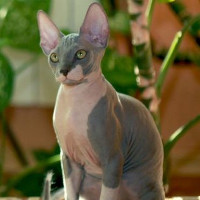|
A brief historical overview
|
| In 1966, a Canadian alley cat gave birth to a litter of naked kittens. Two kittens were brought back to the Netherlands by Doctor Hugo Hernandez, where they were crossed with Devon rexes. An entire litter was imported to France in 1983 by French breeder Patrick Challain, who presented them a year later at the Baltard cat show. In 1985, two more cats were imported from the Netherlands to France by Aline and Philippe Noël, from whom Aménophis Clone was born. This cat served as the basis for the breed's first standard. According to the Livre officiel des origines félines (LOOF), the Sphynx can be considered of French origin. |
General appearance
|
| Contrary to popular belief, the Sphynx is not a fragile cat. Its life expectancy is the same as that of other cats. Nor is it particularly cold, and some cats even love snow. Although it would be inappropriate to let a Sphynx spend the night outside, the cat can go outside in winter if it wishes. Last but not least, its lack of whiskers is not a handicap at all, and it doesn't hit itself any more than other cats. They are excellent hunters. |
Behavior / characteristics
|
| The Sphynx is described as an extremely affectionate, even clingy, cat who likes to live in society. It needs its owner's attention and loves to perch on his shoulders. However, these traits are entirely individual and depend above all on the history of each cat. |
Health
|
Although hairless, the Sphynx requires special care. Sebum is no longer absorbed by the hair and tends to grease the skin. Bathing is necessary, as is supervision in very sunny weather. Sunscreen can also be applied. You should also take care not to leave your cat outside in very cold weather.
Despite its lack of hair, the Sphynx still causes allergy to "cat hair", as it is in fact salivary secretions and sebaceous glands (in the skin) that are at the origin of this allergy. However, their peculiarity is an asset for mildly allergic people insofar as it avoids the dispersion of hairs and thus allergens in their environment. |
Genetics
|
The Sphynx's lack of hair is produced by an allele of the gene that produces short hair in the Devon Rex. The Sphynx allele is dominant over the Devon allele, and both are recessive in the wild type. To reinforce the gene, Sphynx have sometimes been crossed with Devon Rex, which unfortunately often involves serious dental and nervous problems. This practice is therefore prohibited in most Sphynx associations.
Genetic research carried out by the University of California at Davis has reported the presence at very low frequency of the recessive allele responsible for the Sacré de Birmanie's white gantage in Sphynx. A specific genetic test exists to detect the Burmese gantage gene. |
|







 English (United Kingdom)
English (United Kingdom)